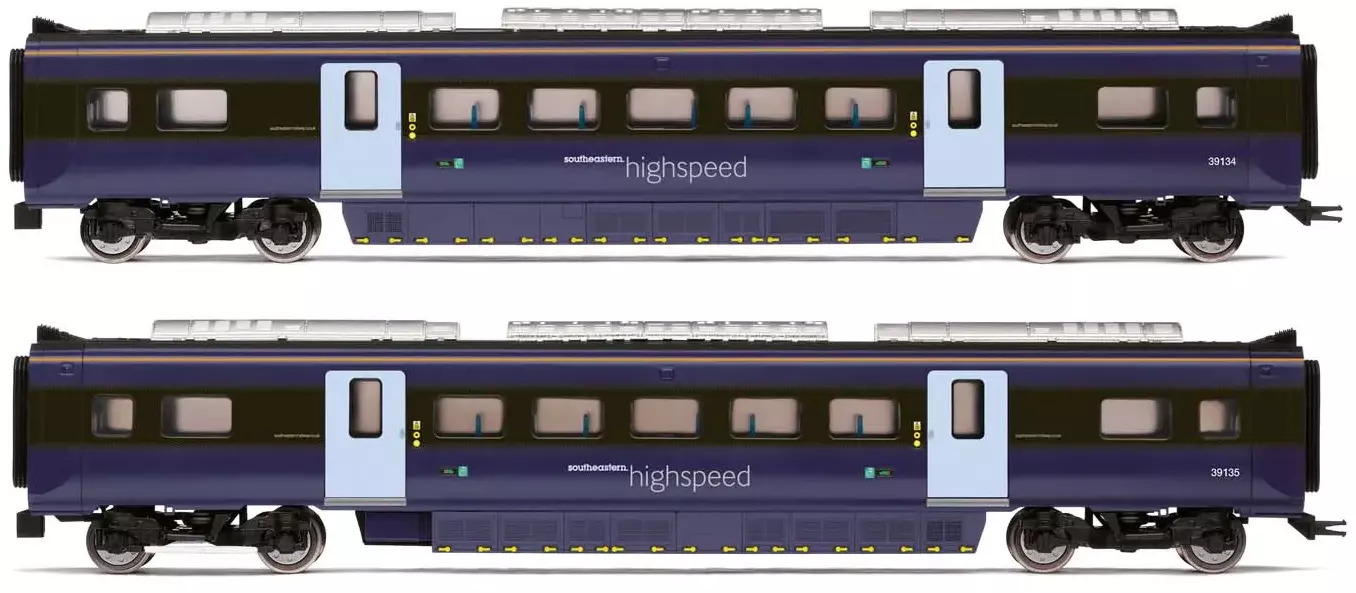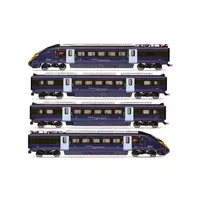Manufacturer catalogue image - please note that pre-release images may be CAD renders or CGI images rather than photographs
Prototype Eras
Era 9 (1995 to 2004) Initial Privatisation
Era 11 (2016 to 2025) Current Era
Manufacturer description
Hitachi Class 395 South Eastern Highspeed Train Pack Set 395 013 'Hornby Visitor Centre' Coach Pack comprises the MSO 39134 and MSO 39135.
The story behind Hitachi's entry to the United Kingdom railway market with the Class 395 Javelin began with Secretary of State for Transport Sir George Young's formal announcement on 29 February 1996 that London & Continental Railways had been awarded the contract to build the Channel Tunnel Rail Link (CTRL). L&CR had included proposals for combined international and domestic stations at Stratford and Ebbsfleet in its tender document. The idea of providing high speed domestic services on to Medway and East Kent was seen as a catalyst for regeneration of these areas.
After several years of procrastination and doubts over government rail spending, by October 2003 the Strategic Rail Authority had outlined plans for domestic services to Ashford, Canterbury, Folkestone, Thanet and Medway with Swale, Dover, Maidstone and Sandwich being added subsequently, once the Government had given CTRL domestic services the green light on 27 October 2004. In 2002, Japan's Hitachi Rail were looking for opportunities to transfer skills and technology to the UK and anticipating that new rolling stock would be required for CTRL, created the V-Train 1 project to test and prove their 'A' Train technology on AC and DC supply for the UK rail network, based on an adapted Class 310 four-car unit with a 4-VEP motor car added to enable third rail traction.
Testing was complete by the end of March 2005 and in June the £250 million contract to construct and deliver twenty-eight six-car dual-voltage sets was awarded to Hitachi Rail Europe by the SRA, rising to twenty nine sets when Dover was added to the roster of domestic services on 29 July 2006. The design of the Class 395 was influenced by the Japanese 400 Series Shinkansen High Speed Train, the prototype for which Hitachi worked on along with Tokyu Car and Kawasaki, and Hitachi's own 885 series A-train aluminium railcar system which had been developed and deployed on high speed routes, as well as commuter and suburban lines. The lightweight, modular design, constructed using friction-stir welding, gave the Class 395 a quiet ride, strong rigidity, improved safety standards and improved air resistance through tunnels, as well as reducing production times to just eight weeks from start to finish. The first completed train, 395 001, arrived at Southampton Docks on 23 August 2007 and was moved to Hitachi's new £53 million maintenance facility at Ashford on 30th August where testing commenced on local lines during October.
On 1st November test running commenced on the CTRL with homologation testing being undertaken by Serco and SNCF International assisting with the testing of signalling systems. By March 2008, 395 001 had been joined by three further sets, with shipping of the main production batch beginning in December 2008. The ORR performance acceptance tests of 4,000 miles fault-free running were achieved six months ahead of schedule, allowing a 'preview' service between London St. Pancras, Ebbsfleet International and Ashford International stations to commence on 29 June 2009. The final three trains arrived in the UK during August 2009, with the final train being delivered to South Eastern on 11 December 2009 just ahead of the official launch of HS1 services on 14th December.
Almost ten years to the day after Class 395 001 preview services commenced, a ceremony at South Eastern's Ramsgate Engineering Depot Open Day on Saturday 8 June officially named Set 395 013 as 'Hornby Visitor Centre', recognising the value to tourism in Thanet that the attraction provides, as well as marking the return to Margate by the manufacturer after an absence of four years.
Catalogue listing
Model details
Prototype information
* Class names often change over the lifespan of a locomotive, so this is not necessarily the class name used by the operator in the period modelled.
Supplier links are provided for your convenience and do not guarantee that the product is currently available. RailwayModels.uk is not a representative of these suppliers, but may receive a commission when purchases are made through links on this page.

